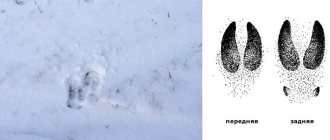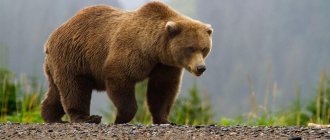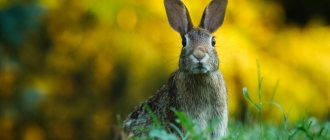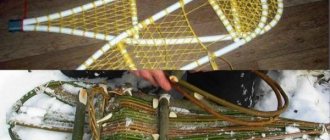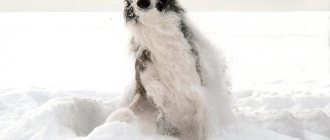Winter is a unique time to learn more about forest inhabitants. The snow all around is embroidered with patterns of footprints. How to recognize a fox track? How to distinguish fox dog track? How to find the Fox on the trail? Follow in the footsteps of the Fox!
The fox trail is easy to recognize in winter. It looks like a dog's, only more elongated and smaller . And usually the fox’s trail is even, regular, elongated in one line, like a seam. Let's take a the Fox's trail .
In shallow snow (or drying mud), the front of each fox paw print is more visible.
The prints of the pads of the two middle toes (both hind and front paws) protrude forward so much that the prints of the pads of the two outer toes remain behind the front ones and cover them from the sides only with the ends of the claws.
The Fox's footprint (especially in females) looks like a boat - the imprints of an elongated paw with tightly clenched fingers.
Fox tracks
An ordinary fox track , left by an animal jogging or running at a large trot, consists of strikingly neat and symmetrical oval pits successively located at an equal distance (about 30-40 centimeters from each other) and strictly along the same line. The line of fox tracks is far from straightforward. Constant prowling in search of prey allows the Fox to examine in detail her entire hunting area. Therefore, fox harnesses consist of the most intricate figures: loops, doubles, numerous entries, pokes, etc.
When traveling long distances, the Fox often trots with a tag and leaves a sort of “marten trail.” In such cases, the usual even chain of fox tracks doubles and one track often captures the edge of the other.
For faster movement and when crossing deep and loose snow, the fox jumps - gallops , leaving prints of all four paws at a distance of 1-2 meters: two front prints scattered and two back prints in one line
Signs and traces of a fox
Fox tracks are characteristic and easily distinguishable from those of closely related species. The fox's gait is regular (as if on a thread), alternating paw prints. During a light trot or “jog,” which is the way the fox moves most often, it places its front left paw and its right hind paw in exactly the same place and then, stepping forward with its right front paw, lowers its left hind paw in its place. It seems that a two-legged animal has passed by. The distance between the paw prints is 20-30 cm. At a slow pace, when the fox sneaks up on the prey, looks closely at the danger, or leaves feeding to rest when well-fed, the distance between the prints is reduced almost to the point of their contact and the print of the hind paw is slightly behind the front paw. When excited and restless, the fox walks at a large trot. In deep snow it breaks into a short gallop, which leaves traces of all four paws. Fleeing from danger, he switches to an extended gallop and quarry. At the same time, she can make jumps up to 4.3 m.
The paw print of a fox is similar to that of a dog, but is more compressed, narrow, and not “spread out”; the contours of the lateral fingers do not touch the posterior edge of the middle fingers and do not cover them from the sides, as is the case in dogs. Claw marks are always visible on a thin layer of soft snow or damp soil. The dimensions of the elongated paw print are 4-5 x 6-7 cm with claws. The load per 1 cm² of the track surface is 40 g or more in the middle zone and 28 g in Pechora.
The female's trail is smaller, narrower and sharper, and her stride is shorter; in juveniles the marks are smaller and not as distinct as in females. The shorter-legged female naturally makes longer and more frequent and longer drags in the snow. The female often walks, hiding behind bushes or uneven terrain, while the male often moves straight, without hiding. During the rut, the female leads the males. The sex of a fox can also be determined by the way it urinates, which males usually do near prominent objects - stones, hummocks or bushes.
Read: Common newt (Lissotriton vulgaris)
The tracks of melanists, especially silver foxes, compared to red ones, differ, according to hunters of Eastern Siberia, in being larger, not only due to the larger size of the paws, but also to their better furring. Melanistic foxes are more careful than red foxes. Hunters believe that the better the fur of a fox, the cleaner its trail. There are individual differences in the footprint, for example, “paw-footing,” when the heavily pubescent soles of the paws leave a wide and vague footprint.
The direction of the fox's movement through deep or crumbly snow is recognized by the drags and drags. The latter, resulting from removing the paw from the footprint, are usually shorter and rise steeply from the snow, breaking its edge; pellets of snow are thrown forward. The cover formed when the paw is lowered onto the snow is elongated and flat.
A chain of fox tracks stretches out, patternedly crossing fields, meadows, bushes, passing through hills, descending into ravines, following the edge of the forest, sometimes walking along a ski track, often entering roads. While searching for food, the fox walks in zigzags, deviating first in one direction or the other, examining every hummock, tuft of grass, oncoming bush, walking around haystacks, dung heaps and not missing a single oncoming object on the snowy surface, sometimes returning along its own path. following The fox does not make trails, since when it follows its tracks a second time or repeatedly, it places its paws neatly in the place of the previous tracks. Only young foxes make trails, usually along the banks of small rivers overgrown with reeds. At different times of the day, the fox walks in special ways and on a bright day hides more often than during a cloudy sky.
During years of abundance of small rodents, holes remain in the snow on the path of the fattening fox through which it caught voles. In deep snow, these “diggings” go up to 80 cm deep (Lapland Nature Reserve). Up to 30 diggings were found along 2 km of the path. Often found on the fox's trail are strangled and abandoned shrews, even moles, which the fox usually does not eat. The shells of eggs, poured in the summer and eaten by a fox in the winter, have 2 holes from the fangs at a distance of 1.5 cm from each other. The remains of a large or medium-sized bird are usually found in the form of whole wings or individual flight or tail feathers, with the feathers gnawed off at the base. A fox that has caught a hare usually does not eat it entirely, but, having dug a hole in the ground or in the snow, puts the rest of the carcass there and, throwing it in, crushes it on top with its paws and nose.
Read: Black kite (Milvus migrans)
The fox's bed is sometimes placed under a bush or near a hummock, often on a hill, on a haystack or on a stack of straw, even on a bent tree at a height of several meters from the ground. In forest areas, the fox prefers coniferous forests for rest - spruce forests, where you can hide among the shaggy paws of spruce, and pine forests with moss swamps, where you can hide behind a hummock. From laying to lying, a fox's trail can stretch for several kilometers. Sometimes, before going to bed, the fox makes a leap - a jump towards some kind of shelter. The dimensions of the bed in the Lapland Nature Reserve are 40 x 50 cm in diameter and up to 10-15 cm in depth.
Burrows outside of breeding season are rarely visited by foxes; Only in extreme cases, during wet weather, severe frosts or hiding from danger, does a fox climb into a hole. The newcomers use the burrows more often.
In the second half of winter, paired tracks of foxes are often found, and during estrus - several animals at once. In this case, you can find traces of fights between males and tufts of hair left in the snow, even drops of blood. In the spring, sticky discharge is found on the trail, indicating estrus, and in years of lack of food and the onset of diseases - bloody mucus.
Feces are usually 1.5-2 cm thick and 3-9 cm long, tightly covered with a film of mucus and well formed, sometimes with a constriction; when fresh it is a dark olive color, and when dried it is whitish and earthy. Most often it consists of rodent hair, sometimes with an admixture of small feathers, large pet hair, pieces of bones, parts of insect chitin, fragments of dry plants, etc. In the summer, especially when there are few rodents, feces are found entirely from the chitinous parts of insects, crumbling in the hands. In the floodplains of the Volga and Kama, when there is a lack of animal food, foxes eat rose hips in winter, and then their excrement is brick-colored. Near the brood hole, at a point at the main entrance, there are fox feces lying around, ranging from 8 to 15 mm thick, depending on age and sex. The remains of prey brought by the fox are also scattered here. Narrow paths lead from the brood hole, which the fox cubs trample in different directions. You can also find pieces of feces and food remains on them.
Read: How are rats like us?
The fox is guided by hearing; 600 steps away she hears the noise of black grouse moving in the trees, at 1/4-1/2 km - the flight of a raven, 100 meters away - the squeak of a mouse. But there are known cases of encounters in nature with completely deaf foxes. The fox's vision is well developed, but it reacts mainly to the movement of an object. The sense of smell is good, but weaker than that of a specialized dog. Obviously, the sense of smell has a short-term effect. The fox moves objects on the ground not only with its paws, but also with its muzzle.
The voice of a fox can be heard before a thunderstorm, in bad weather and during severe frosts, but most often at the beginning of the mating season, when the female barks at the males; usually from dusk until morning. After 2-3 dull and metallic barks, reminiscent of the voice of a small mongrel, a short, monotonous howl follows. The female barks while sitting, raising her muzzle upward. The males do not respond immediately: their barking is more frequent and impatient and ends without a howl with a screeching sound, reminiscent of the cry of a jay or fighting cats.
You might be interested in:
- Sable tracks
- Brown bear tracks
- Fossilized footprints of a giant
- Wolverine tracks
- Field signs of elk
- Signs of the Arctic fox
Subscribe to our channels in
Yandex Zen and Telegram
How long has the fox gone?
To determine the freshness of fox tracks, it is important to remember: a “hot” track is 15-20 minutes old and never has time to freeze during this time. If you pry such a mark under the base with your hand, its hole will fall apart and the so-called “chair” will not work. At the old footprint, the walls of the hole freeze with the surrounding snow and form a “chair” that can be lifted entirely by hand. The strength of this “chair” depends on the age of the mark and the severity of the frost.
Experience can be used to determine the freshness of a track by sight by the relief of snow lumps thrown by the animal's paw onto the surface of the snow cover. In these cases, the fresh trace is clear and blue, while the old one is blurry and whitish.
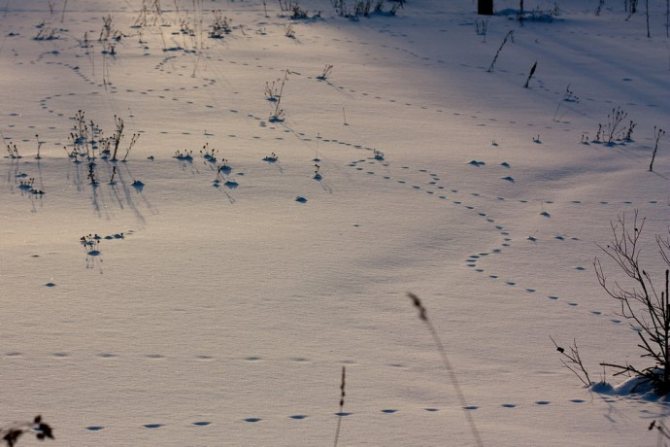
Fox tracks
The fox is a small, well-known predator; it can often be found in places where small rodents are found. Its habitat is fields, river valleys and sparse forests. A hunter for whom a fox is a valuable trophy must first of all be able to identify its trace among the tracks of other predators. Foxes are counted using paw prints.
A hunter especially often tracks a fox on winter days through the snow; for this reason, the main attention should be paid to studying the traces of the intended game. Looking closely at the prints of the red predator on the fine snow, you can notice that the pads of the two middle toes protrude forward, and the prints left by the pads of the two outer toes are behind and cover the front with the tips of the claws from the barrels. To briefly characterize the tracks of the chanterelle, it is worth noting that they represent a type of boat (see photo 1).
Fox tracks have a sign by which a tracker can easily determine which paw (front or back) they were left by. The front legs have a concave crumb, and on the hind legs it is convex. The fox's paw prints are 6.5 by 5 cm. The prints that can be seen on a straight path are located “as if along a thread.” The step length corresponds to 30 sometimes 40 cm.
By carefully examining the tracks of a fox, you can determine its behavior: jumps 3-4 m long, then an instant stop, throws at right angles are often observed in one direction or the other. All this defines the fox as a dexterous, resourceful animal endowed with unique flexibility.
When the fox goes to bed during the rutting period, as well as when moving through areas where there is no food, it moves without looping, thus leaving straight tracks. When a fox travels long distances, it trots. At this time, a doubling of an even chain of tracks of the red cheat occurs; if you look closely, you can see two parallel rows of paw prints. In this case, one mark may slightly capture the edge of another.
To quickly get to the intended place in winter through deep, loose snow, inconvenient for running, the fox does not run, but simply jumps, the prints of four limbs remain at a distance of 1-2 m. While pursuing prey, the fox moves at an extended gallop.
While studying the tracks of a red predator moving through deep snow, you come to the conclusion that they are most often connected by a continuous stripe. Because of this, it is difficult to accurately determine the direction of the animal. But there is a second, rather simple way, using which it is quite easy for knowledgeable people to find out in which direction any forest inhabitants are moving; the fox is also one of them. Experienced hunters and trackers recommend that novice trappers pay attention to blades of grass or twigs sticking out in the snow along the line of tracks. They leave lines by which you can accurately guess in which direction the running animal bent down, which means this will be its planned route.
Determining the freshness of fox and other animal tracks in the snow
A good hunter is one who is an excellent tracker along the white trail. Hunters gave this name to tracks in the snow. Determining when an animal left a print is a very difficult matter. In this small article it is not possible to reveal all the intricacies of this complex science, but you can familiarize yourself with some principles. They will bring invaluable help in the first stages.
Fresh tracks left in winter by fox, bear, hare, wolf and other forest inhabitants are covered with sparkling snowflakes thrown out of the track hole. Some time passes and the marks begin to fade, harden under the influence of frost, and the edges become less noticeable.
The speed at which these processes take place depends on the location where the trace is found, as well as on weather conditions. If the tracks are in the open, they will be covered faster than those that are in a ravine. It is not difficult to calculate when the footprint was left if the time of the last snowfall is known. For example, a small snowfall fell at 9 o’clock in the morning, and at 11 o’clock they already saw a completely fresh print, it turns out that it was left two hours ago.
Experts in this matter give valuable advice: compare your fresh tracks with those being studied. If a slight difference is visible between them, this indicates that the tracks are fresh. If you are planning a hike in the forest, it is recommended to go out into the yard in the evening and leave your handprint there. In the morning, looking at it, you can already know what yesterday’s track should look like in a given state of weather and snow.
This is interesting: How to catch fish without a fishing rod
What is trace freshness and how is it determined?
It is interesting for the observer, and important for the hunter, to know when this or that trace was left. The animal passed here a few days ago, or maybe hours? Or is it still running somewhere ahead? This is indicated by such a concept as the freshness of the trace.
If it snowed late in the evening or at night, then a bear’s paw print found in the morning will indicate that it is nocturnal and no more than a few hours old. You should be careful, because in winter only the connecting rod bear can leave its prints.
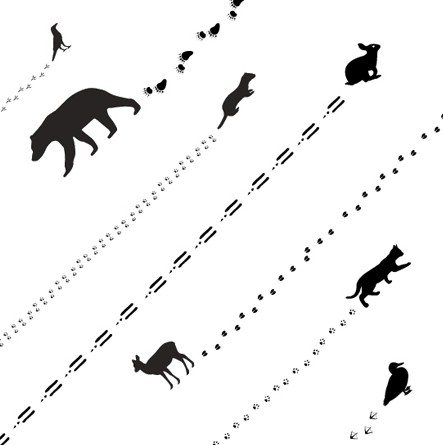
Experts suggest determining the freshness of a trace by touch. If it is frosty outside and the snow is dry, then at first its boundaries will not differ in looseness from the rest of the surface. Over time, the walls of the footprint harden. This process directly depends on the air temperature. The stronger the frost, the faster the edges of the print become hard. But this only applies to large animals, for example, if these are traces of a brown bear or a wolf. Because small animals leave imprints on the surface. And there the hardening is not noticeable.

